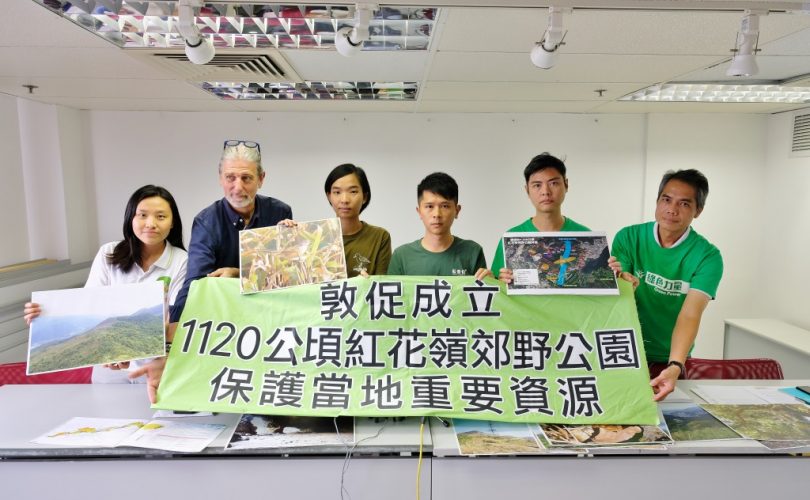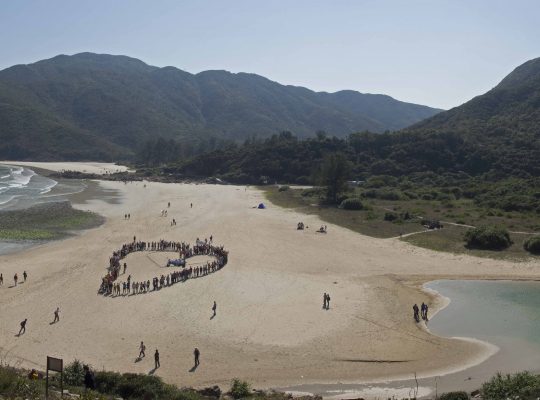16個團體就紅花嶺郊野公園的期望發表聯合聲明,敦促漁農自然護理署盡快成立郊野公園,保育具高生態、歷史、文化及景觀價值的地點,為香港及內地之間提供陸地生態走廊。團體建議的紅花嶺郊野公園範圍佔地1,120公頃,當中超過百分之九十五為政府土地。
政府早已認同保育紅花嶺郊野公園帶來的保育重要性。長春社公共事務經理吳希文指﹕「1993年及2008年,規劃署的『全港發展策略檢討』及『邊境禁區土地規劃研究』分別已建議成立紅花嶺郊野公園。政府在2017年施政報告承諾成立紅花嶺郊野公園,環境局局長黃錦星亦於2018年表明制訂紅花嶺郊野公園的工作正在進行中。紅花嶺的保育價值早已獲得確認,因此政府不應拖延該工作。」
團體認為郊野公園能為紅花嶺及毗鄰地區的重要生態資源提供最適合的保護及管理。香港觀鳥會高級保育主任胡明川解釋﹕「由山咀經新桂田一直延伸至蓮麻坑的紅花嶺北坡,保存著一大片非常完整的次生林,此片樹林及穿插其中的天然溪澗,孕育出眾多原生動植物。這一帶更有兩個具特殊科學價值地點,為本地分佈極窄的斯氏波魚及本港其中一個最重要的蝙蝠羣棲息地。全球易危的大草鶯在香港的族群對其全球數量有舉足輕重的影響,而紅花嶺的高地草原正正是其重要的生境,範圍由紅花嶺南面一直延伸至香園圍及禾徑山,而蓮麻坑及萬屋邊一帶的低地草原也是其潛在渡冬點。紅花嶺南麓也保存著不少由成熟樹木組成的風水林。」
紅花嶺被視為是內地與香港之間現存唯一的陸地生態走廊。其北面的完整次生林與深圳梧桐山國家森林公園有良好的生態連貫性,而南面的樹林及少受干擾的植被在生態上亦與八仙嶺郊野公園連結。綠色力量總監鄭睦奇博士指﹕「這為內地與香港的野生動物,如陸鳥、兩棲類、爬行類以及小型哺乳類等,提供重要的遷徙廊道。故此,紅花嶺的生境必須予以充分保護,以維持兩地的生態連貫性,令野生物種種群能正常交流並健康發展。」
紅花嶺一帶的古蹟具有不同的歷史價值。吳希文指﹕「紅花嶺是本地歷史文化遺產的一部分。位於伯公坳及礦山的二級歷史建築『麥景陶碉堡』,展現昔日其邊防及控制非法移民的角色;散落於紅花嶺四周的破舊設施、機槍堡等,相信是二十世紀興建作防衛用途;蓮麻坑的鉛礦遺址及相關建築,也是香港礦業史的最佳見證。此外,根據規劃署2003年的『香港具景觀價值地點研究』,紅花嶺亦被評為具高景觀價值。」
紅花嶺不單成為附近居民消閒晨運的去處,邊境禁區開放後亦逐漸受遠足郊遊人士及團體歡迎。創建香港行政總裁司馬文指﹕「這些活動反映該區的康樂價值,亦正正顯示制定紅花嶺郊野公園的逼切性,使政府可以提供最適切的保護及管理,以服務郊遊人士及防止人為破壞。《郊野公園條例》比《城市規劃條例》更能有效保育紅花嶺,相關部門能積極管理具保育價值的生境及作恆常巡查。郊野公園內一些生態及景觀重要性較低的地方,可為遊客提供遠足徑、教育及康樂設施,並由有豐富相關經驗的部門設計、管理及維修。使用率低的認可殯葬區及零散現存墓地也可納入郊野公園範圍,透過園內更有效的管制措施防止山火發生及蔓延。」
團體強烈要求漁農自然護理署考慮建議,並根據「指定郊野公園的原則及準則(2011)」擬定紅花嶺郊野公園的界線。根據該原則及準則,保育價值、康樂發展潛力、景觀及美觀價值為制定郊野公園的三大重要元素及固有準則,即使某地點包含私人土地,當局也不可機械式地視之為不把該地點納入郊野公園的決定性因素。為了對這些地方作更有效的保護與管理,上述眾多具高生態及人文歷史保育價值、景觀價值及康樂發展潛力的地點,應該成為紅花嶺郊野公園的一部分。
六個發起團體(排名不分先後)﹕
長春社、創建香港、綠色力量、香港觀鳥會、香港鄉郊基金、嘉道理農場暨植物園
支持團體(排名不分先後)﹕
香港地貌岩石保育協會、香港大學學生會理學會生態學及生物多樣性學會、香港地球之友、海下之友有限公司、綠領行動、綠色和平、環保觸覺、Hong Kong Outdoors、島嶼活力行動、西貢護牛天使
16 groups have jointly announced a joint statement on the expectations on the upcoming designation of Robin’s Nest Country Park (RNCP). The groups urge Agriculture, Fisheries and Conservation Department (AFCD) to conserve areas of high ecological, historical, cultural, landscape conservation significance under the Country Park system as soon as possible, and to protect and strengthen the important terrestrial ecological corridor between Hong Kong and mainland China. A RNCP boundary was proposed for the consideration of AFCD, covering 1,120 hectares of land with over 95% of government land.
The conservation importance of RNCP has long been recognized by the Government. Roy Ng Hei Man, Campaign Manager of The Conservancy Association, mentioned that “Back in 1993 and 2008, the Territorial Development Strategy Review Study and feasibility study of the Land Use Planning for the Frontier Closed Area by the Planning Department have already recommended the designation of the RNCP respectively. The Government promised in the 2017 Policy Address that Robin’s Nest will be designated as a Country Park while The Secretary of Environment Mr. Wong Kam Sing also confirmed in December 2018 that the designation of the RNCP is on its way. It is clear that the conservation of Robin’s Nest is well-recognized and the Government should therefore not further delay the designation”.
The groups consider that the Country Park system is suitable for the protection, conservation and management of important ecological resources in the Robin’s Nest and associated areas. Woo Ming Chuan, Senior Conservation Officer of The Hong Kong Bird Watching Society, said that “The northern slope of Robin’s Nest, extending from Shan Tsui to San Kwai Tin and Lin Ma Hang, is well covered with continuous secondary woodland intermingled with natural streams of conservation concern. It thus supports a high diversity of flora and fauna. Two Sites of Special Scientific Interest (SSSIs) were even designated in this area for the conservation of the highly restricted, rare freshwater fish Chinese Rasbora and one of the most important bat colonies in Hong Kong. The globally vulnerable Chinese Grassbird preferred upland grassland habitat stretches from the southern slope of Robin’s Nest to Wo Keng Shan and Heung Yuen Wai, while the lowland grasslands at Lin Ma Hang and Man Uk Pin are potential wintering sites of this species. Many large fung shui woodlands with mature trees are found along the foot of the southern slope of Robin’s Nest”.
Robin’s Nest is well-recognized as the only obvious terrestrial ecological corridor between Hong Kong and mainland China, with continuous secondary woodland at the northern slope ecologically connected to the Wutongshan National Forest Park in Shenzhen while strips of woodlands and other undisturbed vegetated areas at the southern slope are linked to those at the Pat Sin Leng Country Park. Dr. Cheng Luk Ki, Director of Green Power, said, “This corridor is the only well-vegetated pathway with little built-up area where wild animals (e.g. land birds, reptiles, amphibians, small mammals) can still move between Hong Kong and Shenzhen/Guangdong, thus their population in these two places can be healthily sustained. Therefore, all the habitats along this corridor should be well-protected to maintain such ecological connectivity both across and within the Hong Kong border”.
Various heritage resources within the Robin’s Nest area have different local historical interest or significance. Roy Ng added, “For example, the Grade-2-listed Macintosh Forts at Pak Kung Au and Kong Shan served the role in bringing law and order to the frontier and in the control of illegal immigration. Some ruins, pillboxes and other structures are believed to have been built for defensive purpose during the 20th century. Lin Ma Hang Lead Mine and its adjacent ruins form good evidence in reflecting Hong Kong’s mining history. The hilly terrain of Robin’s Nest is also identified as being of high landscape value in the Landscape Value Mapping of Hong Kong by the Planning Department in 2003”.
Robin’s Nest is not only used by local people for passive recreational activities, but is also becoming more popular among hikers and the public since the opening-up of the Frontier Closed Area. Paul Zimmerman, Chief Executive of Designing Hong Kong, said “All these activities indicate the recreational potential of Robin’s Nest, and the urgency of the Country Park designation, in order to provide better habitat protection and management for the enjoyment of the public. The Country Park Ordinance (Cap. 208) would offer a higher level of protection than the land use control under the Town Planning Ordinance (Cap. 131). Habitats of conservation concern can be actively managed and protected with regular patrols. Facilities for visitors and hiking routes can be designed, provided and maintained in the ecologically and scenically less-sensitive areas of the Country Park, for public education and enjoyment. Existing graves and burial grounds can be respected and managed within the Country Park for better regulation and fire prevention”.
The groups strongly urge AFCD to consider the proposal and define the boundary of the RNCP according to the “Principles and Criteria for Designating Country Parks (2011)” (2011 Principles and Criteria). From the 2011 Principles and Criteria, conservation value, recreation potential as well as landscape and aesthetic value are the key themes of the intrinsic criteria for identifying suitable areas for designating Country Parks, while private land is not automatically taken as a determining factor for exclusion from the Country Park boundary. The aforementioned areas of high ecological, historical, cultural and landscape value should therefore be included within the boundary of RNCP for nature and heritage conservation and management.
Six co-organized groups (in alphabetical order):
The Conservancy Association, Designing Hong Kong, Green Power, The Hong Kong Bird Watching Society, The Hong Kong Countryside Foundation, Kadoorie Farm and Botanic Garden
Supporting organizations (in alphabetical order):
Association for Geoconservation, Hong Kong, Ecology & Biodiversity Society, SS, HKUSU, Friends of the Earth (HK), Friends of Hoi Ha, Greeners Action, Greenpeace, Greensense, Hong Kong Outdoors, Living Islands Movement, Sai Kung Cattle’s Angel





